Analysis of the New Corporate Whistleblowing Legislation in Australia
VerifiedAdded on 2023/03/20
|12
|3433
|24
Report
AI Summary
This report provides a comprehensive analysis of Australia's new corporate whistleblowing legislation, focusing on its background, intent, and implications for companies, specifically AMP Limited. The report examines the key changes in the new legislation compared to the previous one, highlighting the increased protections for whistleblowers and the expanded scope of disclosures. It also delves into the theoretical underpinnings of corporate whistleblowing, exploring various accounting theories and their relevance to the implementation of whistleblowing policies. The report further assesses the implications of the new legislation for AMP Limited's Code of Conduct and provides recommendations for the company to align with the new requirements. The findings emphasize the importance of establishing appropriate procedures for receiving and investigating protected disclosures, providing training to relevant personnel, and creating whistleblowing policies in line with the new legislation. The report concludes by underscoring the significance of corporate whistleblowing in promoting good corporate governance and fraud reduction, offering valuable insights for businesses operating in Australia.

Corporate Whistleblowing 1
Corporate Whistleblowing legislation in Australia
by Student Name
Class & Course
Professor
University
The City & State
Date
Words: 2199
Corporate Whistleblowing legislation in Australia
by Student Name
Class & Course
Professor
University
The City & State
Date
Words: 2199
Paraphrase This Document
Need a fresh take? Get an instant paraphrase of this document with our AI Paraphraser
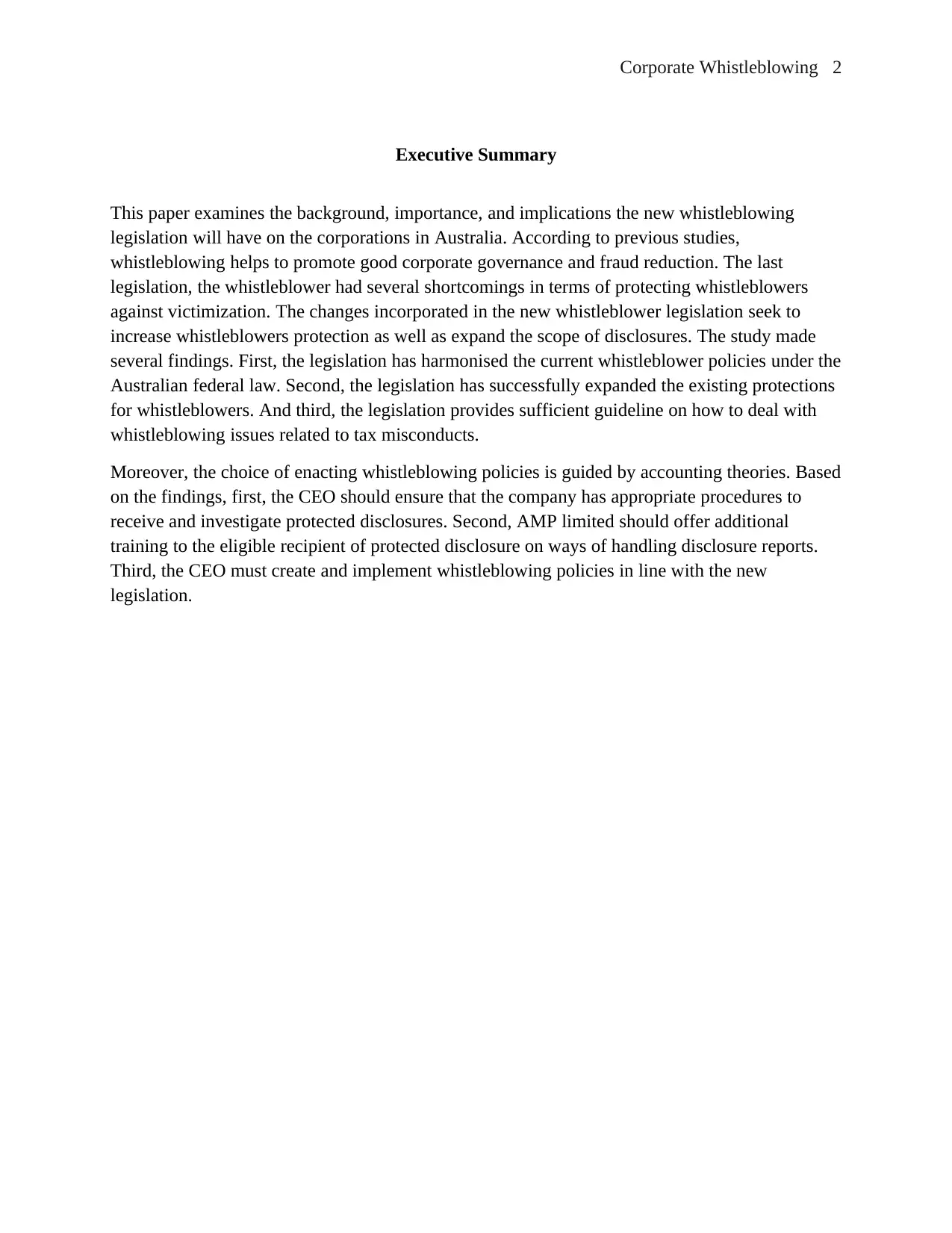
Corporate Whistleblowing 2
Executive Summary
This paper examines the background, importance, and implications the new whistleblowing
legislation will have on the corporations in Australia. According to previous studies,
whistleblowing helps to promote good corporate governance and fraud reduction. The last
legislation, the whistleblower had several shortcomings in terms of protecting whistleblowers
against victimization. The changes incorporated in the new whistleblower legislation seek to
increase whistleblowers protection as well as expand the scope of disclosures. The study made
several findings. First, the legislation has harmonised the current whistleblower policies under the
Australian federal law. Second, the legislation has successfully expanded the existing protections
for whistleblowers. And third, the legislation provides sufficient guideline on how to deal with
whistleblowing issues related to tax misconducts.
Moreover, the choice of enacting whistleblowing policies is guided by accounting theories. Based
on the findings, first, the CEO should ensure that the company has appropriate procedures to
receive and investigate protected disclosures. Second, AMP limited should offer additional
training to the eligible recipient of protected disclosure on ways of handling disclosure reports.
Third, the CEO must create and implement whistleblowing policies in line with the new
legislation.
Executive Summary
This paper examines the background, importance, and implications the new whistleblowing
legislation will have on the corporations in Australia. According to previous studies,
whistleblowing helps to promote good corporate governance and fraud reduction. The last
legislation, the whistleblower had several shortcomings in terms of protecting whistleblowers
against victimization. The changes incorporated in the new whistleblower legislation seek to
increase whistleblowers protection as well as expand the scope of disclosures. The study made
several findings. First, the legislation has harmonised the current whistleblower policies under the
Australian federal law. Second, the legislation has successfully expanded the existing protections
for whistleblowers. And third, the legislation provides sufficient guideline on how to deal with
whistleblowing issues related to tax misconducts.
Moreover, the choice of enacting whistleblowing policies is guided by accounting theories. Based
on the findings, first, the CEO should ensure that the company has appropriate procedures to
receive and investigate protected disclosures. Second, AMP limited should offer additional
training to the eligible recipient of protected disclosure on ways of handling disclosure reports.
Third, the CEO must create and implement whistleblowing policies in line with the new
legislation.
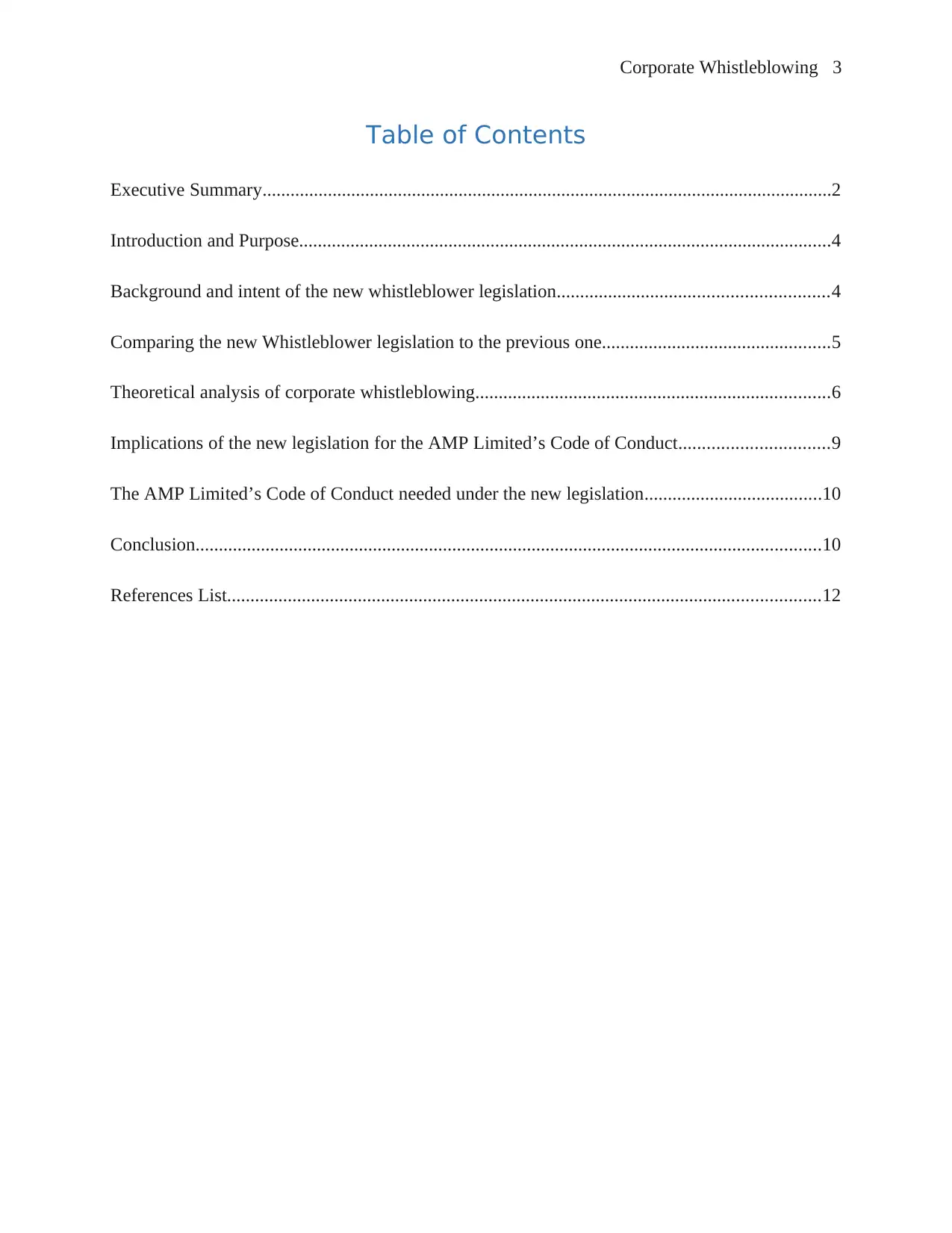
Corporate Whistleblowing 3
Table of Contents
Executive Summary..........................................................................................................................2
Introduction and Purpose..................................................................................................................4
Background and intent of the new whistleblower legislation..........................................................4
Comparing the new Whistleblower legislation to the previous one.................................................5
Theoretical analysis of corporate whistleblowing............................................................................6
Implications of the new legislation for the AMP Limited’s Code of Conduct................................9
The AMP Limited’s Code of Conduct needed under the new legislation......................................10
Conclusion......................................................................................................................................10
References List...............................................................................................................................12
Table of Contents
Executive Summary..........................................................................................................................2
Introduction and Purpose..................................................................................................................4
Background and intent of the new whistleblower legislation..........................................................4
Comparing the new Whistleblower legislation to the previous one.................................................5
Theoretical analysis of corporate whistleblowing............................................................................6
Implications of the new legislation for the AMP Limited’s Code of Conduct................................9
The AMP Limited’s Code of Conduct needed under the new legislation......................................10
Conclusion......................................................................................................................................10
References List...............................................................................................................................12
⊘ This is a preview!⊘
Do you want full access?
Subscribe today to unlock all pages.

Trusted by 1+ million students worldwide

Corporate Whistleblowing 4
Introduction and Purpose
The protection and safeguarding the rights of whistleblowers have been an issue globally.
Whistleblowing plays an integral role in scrutinizing Australian organisations. The managements
of ASX listed companies are concerned about the content and the implications on the new
whistleblower law. This report is addressed to the CEO of AMP Limited (ASX: AMP) who
inquired about the new legislation and how it would affected current codes of ethics and
corporate governance in the Australian financial sector.
The report is divided into five sections to address the CEO’s concerns. The introductory section
explains the background and purpose of the whistleblower law 2019. The second section compare
the new legislation to the previous one. The third section covers literature reviews on several
theories that relate to corporate whistleblowing. The fourth section evaluates the implications of
the new legislation for the company in terms of procedures and the company’s Code of Conduct.
The fifth section examines elements of the ASX-100 Code of Conduct that will help AMP
Limited to meet the requirements of the new legislation
Background and intent of the new whistleblower legislation
The Australian Whistle-blower Bill was passed into law by the parliament on February 19, 2019.
The passing of the new law was preceded by years of consultation, drafting of proposals and
committee hearing. However, the law is expected to take effect on July 1, 2019, after it received
a Royal Assent. The law focuses on three key areas. First, harmonise the current whistleblower
policies under the Australian federal law. Second, expand the existing protections for
whistleblowers. And third, provide a guideline on how to deal with whistleblowing issues related
to tax misconducts.
The new legislation intends to address several loopholes available under the previous
whistleblower law. The following are the objectives of the new legislation.1
i) Australian companies will be required to establish mandatory whistleblower policies with
acceptable content.
1 A. McGregor, 2019. A new era for Whistleblowers in Australia. [Online]
Available at: https://www.nortonrosefulbright.com/en/knowledge/publications/63b0f230/update-on-new-
whistleblower-protection-laws-in-australia
[Accessed 13 May 2019].
Introduction and Purpose
The protection and safeguarding the rights of whistleblowers have been an issue globally.
Whistleblowing plays an integral role in scrutinizing Australian organisations. The managements
of ASX listed companies are concerned about the content and the implications on the new
whistleblower law. This report is addressed to the CEO of AMP Limited (ASX: AMP) who
inquired about the new legislation and how it would affected current codes of ethics and
corporate governance in the Australian financial sector.
The report is divided into five sections to address the CEO’s concerns. The introductory section
explains the background and purpose of the whistleblower law 2019. The second section compare
the new legislation to the previous one. The third section covers literature reviews on several
theories that relate to corporate whistleblowing. The fourth section evaluates the implications of
the new legislation for the company in terms of procedures and the company’s Code of Conduct.
The fifth section examines elements of the ASX-100 Code of Conduct that will help AMP
Limited to meet the requirements of the new legislation
Background and intent of the new whistleblower legislation
The Australian Whistle-blower Bill was passed into law by the parliament on February 19, 2019.
The passing of the new law was preceded by years of consultation, drafting of proposals and
committee hearing. However, the law is expected to take effect on July 1, 2019, after it received
a Royal Assent. The law focuses on three key areas. First, harmonise the current whistleblower
policies under the Australian federal law. Second, expand the existing protections for
whistleblowers. And third, provide a guideline on how to deal with whistleblowing issues related
to tax misconducts.
The new legislation intends to address several loopholes available under the previous
whistleblower law. The following are the objectives of the new legislation.1
i) Australian companies will be required to establish mandatory whistleblower policies with
acceptable content.
1 A. McGregor, 2019. A new era for Whistleblowers in Australia. [Online]
Available at: https://www.nortonrosefulbright.com/en/knowledge/publications/63b0f230/update-on-new-
whistleblower-protection-laws-in-australia
[Accessed 13 May 2019].
Paraphrase This Document
Need a fresh take? Get an instant paraphrase of this document with our AI Paraphraser

Corporate Whistleblowing 5
ii) Facilitate the creation of protected disclosures which address misconducts such as improper
practices in the corporate sector.
iii) Offer more protection to the disclosures by eligible whistleblowers compared to the
previous legislation.
iv) Considering that disclosures are provided to eligible recipient and employees, therefore,
whistleblowers should not be victimised. The law seeks to protect the employees on this
basis.
v) Allow anonymous disclosures where whistleblowers believe that their privacy and
confidentiality is likely to be jeopardised. The provision did not exist under the previous
legislation.
Comparing the new Whistleblower legislation to the previous one
The changes that have been introduced in the new whistleblower legislation seek to increase
whistleblowers protection as well as expand the scope of disclosures. Several changes have been
introduced which make the law different from the previous one.
First, the range of conducts that can be reported and protection offered to the whistleblowers has
been expanded. The new legislation has broadened the scope of whistleblower’s protection to
include conducts related to “improper state of affairs” and “misconduct. The previous law limited
protected disclosures to the provisions of the Corporation Act. Second, the previous legislation
did not allow whistleblowers to make anonymous disclosures. Anonymous disclosure is now
permitted under the new law.2 Third, the new legislation does not oblige whistleblowers to make
their disclosure in good faith as far as there is a reasonable ground to believe that a misconduct
has occurred. The previous legislation made it mandatory that disclosures must be made in good
faith. Fourth, the previous law provided protected disclosures which were attributed to personal
work-related grievances. The new legislation limits the provision of protected disclosures
instigates by work-related differences.3
2 A. McGregor, 2019. A new era for Whistleblowers in Australia. [Online]
Available at: https://www.nortonrosefulbright.com/en/knowledge/publications/63b0f230/update-on-new-
whistleblower-protection-laws-in-australia
[Accessed 13 May 2019].
3 Ibid.,
ii) Facilitate the creation of protected disclosures which address misconducts such as improper
practices in the corporate sector.
iii) Offer more protection to the disclosures by eligible whistleblowers compared to the
previous legislation.
iv) Considering that disclosures are provided to eligible recipient and employees, therefore,
whistleblowers should not be victimised. The law seeks to protect the employees on this
basis.
v) Allow anonymous disclosures where whistleblowers believe that their privacy and
confidentiality is likely to be jeopardised. The provision did not exist under the previous
legislation.
Comparing the new Whistleblower legislation to the previous one
The changes that have been introduced in the new whistleblower legislation seek to increase
whistleblowers protection as well as expand the scope of disclosures. Several changes have been
introduced which make the law different from the previous one.
First, the range of conducts that can be reported and protection offered to the whistleblowers has
been expanded. The new legislation has broadened the scope of whistleblower’s protection to
include conducts related to “improper state of affairs” and “misconduct. The previous law limited
protected disclosures to the provisions of the Corporation Act. Second, the previous legislation
did not allow whistleblowers to make anonymous disclosures. Anonymous disclosure is now
permitted under the new law.2 Third, the new legislation does not oblige whistleblowers to make
their disclosure in good faith as far as there is a reasonable ground to believe that a misconduct
has occurred. The previous legislation made it mandatory that disclosures must be made in good
faith. Fourth, the previous law provided protected disclosures which were attributed to personal
work-related grievances. The new legislation limits the provision of protected disclosures
instigates by work-related differences.3
2 A. McGregor, 2019. A new era for Whistleblowers in Australia. [Online]
Available at: https://www.nortonrosefulbright.com/en/knowledge/publications/63b0f230/update-on-new-
whistleblower-protection-laws-in-australia
[Accessed 13 May 2019].
3 Ibid.,
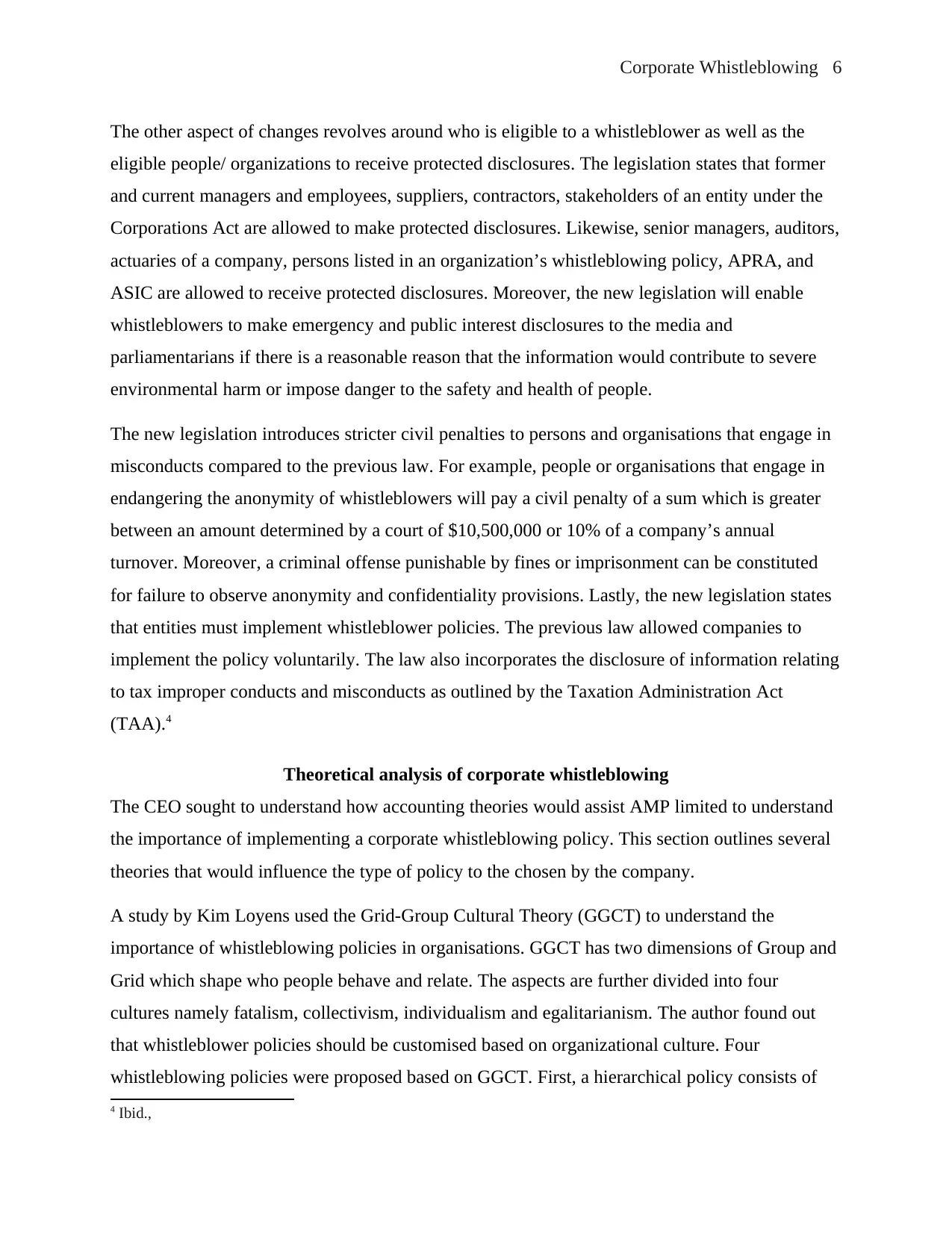
Corporate Whistleblowing 6
The other aspect of changes revolves around who is eligible to a whistleblower as well as the
eligible people/ organizations to receive protected disclosures. The legislation states that former
and current managers and employees, suppliers, contractors, stakeholders of an entity under the
Corporations Act are allowed to make protected disclosures. Likewise, senior managers, auditors,
actuaries of a company, persons listed in an organization’s whistleblowing policy, APRA, and
ASIC are allowed to receive protected disclosures. Moreover, the new legislation will enable
whistleblowers to make emergency and public interest disclosures to the media and
parliamentarians if there is a reasonable reason that the information would contribute to severe
environmental harm or impose danger to the safety and health of people.
The new legislation introduces stricter civil penalties to persons and organisations that engage in
misconducts compared to the previous law. For example, people or organisations that engage in
endangering the anonymity of whistleblowers will pay a civil penalty of a sum which is greater
between an amount determined by a court of $10,500,000 or 10% of a company’s annual
turnover. Moreover, a criminal offense punishable by fines or imprisonment can be constituted
for failure to observe anonymity and confidentiality provisions. Lastly, the new legislation states
that entities must implement whistleblower policies. The previous law allowed companies to
implement the policy voluntarily. The law also incorporates the disclosure of information relating
to tax improper conducts and misconducts as outlined by the Taxation Administration Act
(TAA).4
Theoretical analysis of corporate whistleblowing
The CEO sought to understand how accounting theories would assist AMP limited to understand
the importance of implementing a corporate whistleblowing policy. This section outlines several
theories that would influence the type of policy to the chosen by the company.
A study by Kim Loyens used the Grid-Group Cultural Theory (GGCT) to understand the
importance of whistleblowing policies in organisations. GGCT has two dimensions of Group and
Grid which shape who people behave and relate. The aspects are further divided into four
cultures namely fatalism, collectivism, individualism and egalitarianism. The author found out
that whistleblower policies should be customised based on organizational culture. Four
whistleblowing policies were proposed based on GGCT. First, a hierarchical policy consists of
4 Ibid.,
The other aspect of changes revolves around who is eligible to a whistleblower as well as the
eligible people/ organizations to receive protected disclosures. The legislation states that former
and current managers and employees, suppliers, contractors, stakeholders of an entity under the
Corporations Act are allowed to make protected disclosures. Likewise, senior managers, auditors,
actuaries of a company, persons listed in an organization’s whistleblowing policy, APRA, and
ASIC are allowed to receive protected disclosures. Moreover, the new legislation will enable
whistleblowers to make emergency and public interest disclosures to the media and
parliamentarians if there is a reasonable reason that the information would contribute to severe
environmental harm or impose danger to the safety and health of people.
The new legislation introduces stricter civil penalties to persons and organisations that engage in
misconducts compared to the previous law. For example, people or organisations that engage in
endangering the anonymity of whistleblowers will pay a civil penalty of a sum which is greater
between an amount determined by a court of $10,500,000 or 10% of a company’s annual
turnover. Moreover, a criminal offense punishable by fines or imprisonment can be constituted
for failure to observe anonymity and confidentiality provisions. Lastly, the new legislation states
that entities must implement whistleblower policies. The previous law allowed companies to
implement the policy voluntarily. The law also incorporates the disclosure of information relating
to tax improper conducts and misconducts as outlined by the Taxation Administration Act
(TAA).4
Theoretical analysis of corporate whistleblowing
The CEO sought to understand how accounting theories would assist AMP limited to understand
the importance of implementing a corporate whistleblowing policy. This section outlines several
theories that would influence the type of policy to the chosen by the company.
A study by Kim Loyens used the Grid-Group Cultural Theory (GGCT) to understand the
importance of whistleblowing policies in organisations. GGCT has two dimensions of Group and
Grid which shape who people behave and relate. The aspects are further divided into four
cultures namely fatalism, collectivism, individualism and egalitarianism. The author found out
that whistleblower policies should be customised based on organizational culture. Four
whistleblowing policies were proposed based on GGCT. First, a hierarchical policy consists of
4 Ibid.,
⊘ This is a preview!⊘
Do you want full access?
Subscribe today to unlock all pages.

Trusted by 1+ million students worldwide

Corporate Whistleblowing 7
clear rules which are endorsed and supported by the staff. Second, the egalitarian policy uses
informal rules because employees enjoy equal rights. Third, individualistic policy relies on the
incentive to encourage whistleblowing. Fourth, a fatalistic policy which invite anonymity culture
where company use hotlines to promote whistleblowing.5
Julio A. Andrade used the critical complexity theory to study the dilemma associated with
internal/external whistleblowing. The theory states that the complex nature of systems is caused
by interactions between the system and the environment/ society. The theory maintains that
whistleblowers represent the interest of the community in addressing the standoff between social
welfare and business activities. The author concluded that organisations should stop treated
internal whistleblowers as a loyal and external whistle as enemies. Whistleblowers should be
viewed as representative of social conscience in organizations.6
Esther Pittroff applies legitimacy theory to study the motivation behind the implementation of
whistleblowing systems by organisations in Germany. Legitimacy theory represents a social
contract which requires corporates to disclosure their CSR investments and environmental
performance. The author stated that whistleblowing is a fundamental component of the social
contract. Organizations should be consistency in meeting social expectations. Implementation
policies help organizations to become legitimate before society.7
Esther Pittroff also studied different whistleblowing approaches used by organizations using the
path dependence theory. The theory maintains that legal and social environments influence the
difference in institutional development. An organization is effective when systems of governance
support each other. Therefore, whistleblowing regulations should be integrated and supported by
the whole governance setting in a company. Whistleblowing regulation should not be applied
selectively but become put of an organization to be effective.8
5 Kim Loyens, 2012. Towards a Custom-Made Whistleblowing Policy. Using Grid-Group Cultural Theory to Match
Policy Measures to Different Styles of Peer Reporting. Journal of Business Ethics, pp. 239-249114.
6 Julio. A. Andrade, 2015. Reconceptualising Whistleblowing in a Complex World. Journal of Business Ethics,
Volume 128, pp. 321-335.
7 Esther Pittroff, 2014. Whistle-Blowing Systems and Legitimacy Theory: A Study of the Motivation to Implement
Whistle-Blowing Systems in German Organizations. Journal of Business Ethics, Volume 24, pp. 399-412.
8Esther Pittroff, 2014. Whistle-Blowing Systems and Legitimacy Theory: A Study of the Motivation to Implement
Whistle-Blowing Systems in German Organizations. Journal of Business Ethics, Volume 24, pp. 399-412.
clear rules which are endorsed and supported by the staff. Second, the egalitarian policy uses
informal rules because employees enjoy equal rights. Third, individualistic policy relies on the
incentive to encourage whistleblowing. Fourth, a fatalistic policy which invite anonymity culture
where company use hotlines to promote whistleblowing.5
Julio A. Andrade used the critical complexity theory to study the dilemma associated with
internal/external whistleblowing. The theory states that the complex nature of systems is caused
by interactions between the system and the environment/ society. The theory maintains that
whistleblowers represent the interest of the community in addressing the standoff between social
welfare and business activities. The author concluded that organisations should stop treated
internal whistleblowers as a loyal and external whistle as enemies. Whistleblowers should be
viewed as representative of social conscience in organizations.6
Esther Pittroff applies legitimacy theory to study the motivation behind the implementation of
whistleblowing systems by organisations in Germany. Legitimacy theory represents a social
contract which requires corporates to disclosure their CSR investments and environmental
performance. The author stated that whistleblowing is a fundamental component of the social
contract. Organizations should be consistency in meeting social expectations. Implementation
policies help organizations to become legitimate before society.7
Esther Pittroff also studied different whistleblowing approaches used by organizations using the
path dependence theory. The theory maintains that legal and social environments influence the
difference in institutional development. An organization is effective when systems of governance
support each other. Therefore, whistleblowing regulations should be integrated and supported by
the whole governance setting in a company. Whistleblowing regulation should not be applied
selectively but become put of an organization to be effective.8
5 Kim Loyens, 2012. Towards a Custom-Made Whistleblowing Policy. Using Grid-Group Cultural Theory to Match
Policy Measures to Different Styles of Peer Reporting. Journal of Business Ethics, pp. 239-249114.
6 Julio. A. Andrade, 2015. Reconceptualising Whistleblowing in a Complex World. Journal of Business Ethics,
Volume 128, pp. 321-335.
7 Esther Pittroff, 2014. Whistle-Blowing Systems and Legitimacy Theory: A Study of the Motivation to Implement
Whistle-Blowing Systems in German Organizations. Journal of Business Ethics, Volume 24, pp. 399-412.
8Esther Pittroff, 2014. Whistle-Blowing Systems and Legitimacy Theory: A Study of the Motivation to Implement
Whistle-Blowing Systems in German Organizations. Journal of Business Ethics, Volume 24, pp. 399-412.
Paraphrase This Document
Need a fresh take? Get an instant paraphrase of this document with our AI Paraphraser
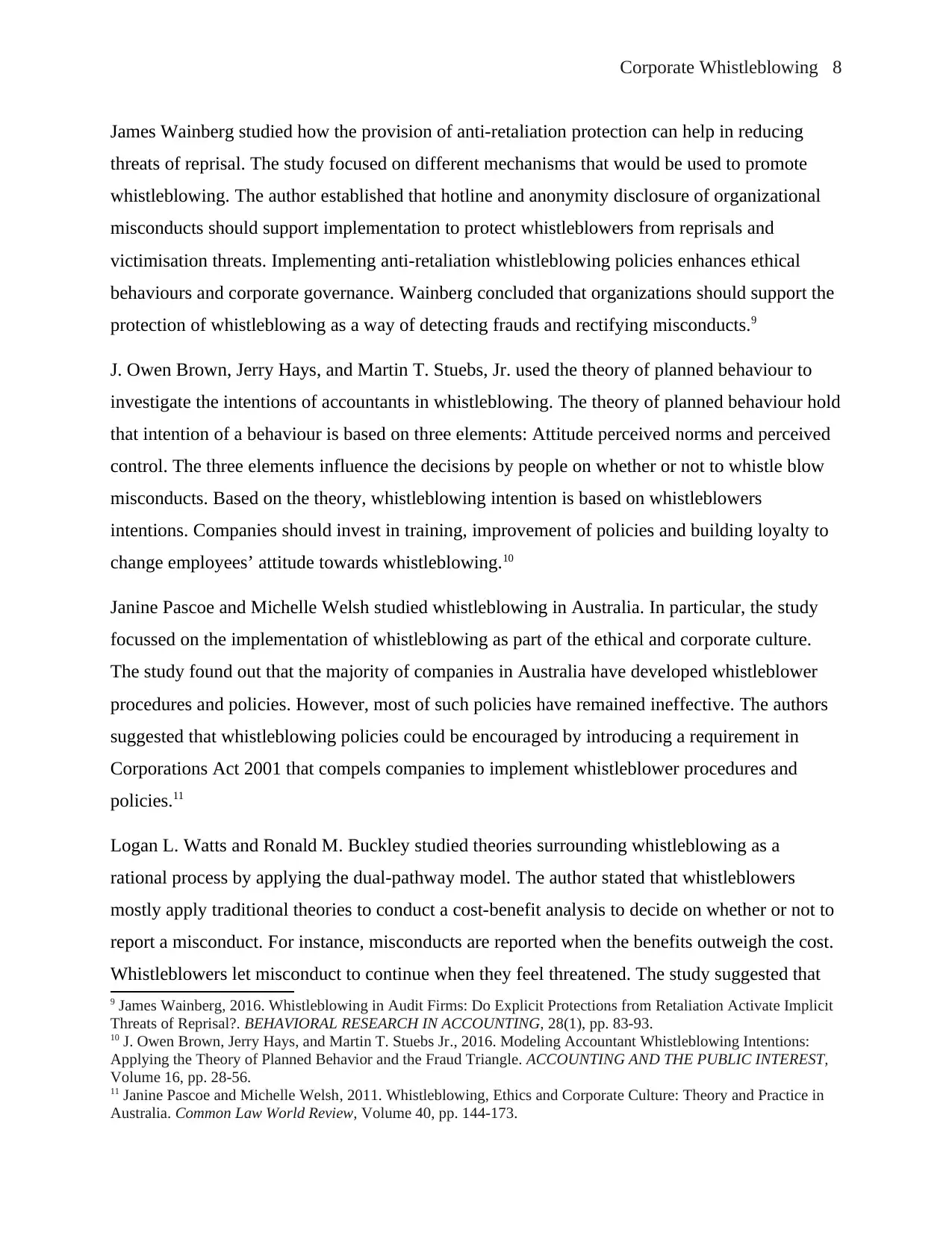
Corporate Whistleblowing 8
James Wainberg studied how the provision of anti-retaliation protection can help in reducing
threats of reprisal. The study focused on different mechanisms that would be used to promote
whistleblowing. The author established that hotline and anonymity disclosure of organizational
misconducts should support implementation to protect whistleblowers from reprisals and
victimisation threats. Implementing anti-retaliation whistleblowing policies enhances ethical
behaviours and corporate governance. Wainberg concluded that organizations should support the
protection of whistleblowing as a way of detecting frauds and rectifying misconducts.9
J. Owen Brown, Jerry Hays, and Martin T. Stuebs, Jr. used the theory of planned behaviour to
investigate the intentions of accountants in whistleblowing. The theory of planned behaviour hold
that intention of a behaviour is based on three elements: Attitude perceived norms and perceived
control. The three elements influence the decisions by people on whether or not to whistle blow
misconducts. Based on the theory, whistleblowing intention is based on whistleblowers
intentions. Companies should invest in training, improvement of policies and building loyalty to
change employees’ attitude towards whistleblowing.10
Janine Pascoe and Michelle Welsh studied whistleblowing in Australia. In particular, the study
focussed on the implementation of whistleblowing as part of the ethical and corporate culture.
The study found out that the majority of companies in Australia have developed whistleblower
procedures and policies. However, most of such policies have remained ineffective. The authors
suggested that whistleblowing policies could be encouraged by introducing a requirement in
Corporations Act 2001 that compels companies to implement whistleblower procedures and
policies.11
Logan L. Watts and Ronald M. Buckley studied theories surrounding whistleblowing as a
rational process by applying the dual-pathway model. The author stated that whistleblowers
mostly apply traditional theories to conduct a cost-benefit analysis to decide on whether or not to
report a misconduct. For instance, misconducts are reported when the benefits outweigh the cost.
Whistleblowers let misconduct to continue when they feel threatened. The study suggested that
9 James Wainberg, 2016. Whistleblowing in Audit Firms: Do Explicit Protections from Retaliation Activate Implicit
Threats of Reprisal?. BEHAVIORAL RESEARCH IN ACCOUNTING, 28(1), pp. 83-93.
10 J. Owen Brown, Jerry Hays, and Martin T. Stuebs Jr., 2016. Modeling Accountant Whistleblowing Intentions:
Applying the Theory of Planned Behavior and the Fraud Triangle. ACCOUNTING AND THE PUBLIC INTEREST,
Volume 16, pp. 28-56.
11 Janine Pascoe and Michelle Welsh, 2011. Whistleblowing, Ethics and Corporate Culture: Theory and Practice in
Australia. Common Law World Review, Volume 40, pp. 144-173.
James Wainberg studied how the provision of anti-retaliation protection can help in reducing
threats of reprisal. The study focused on different mechanisms that would be used to promote
whistleblowing. The author established that hotline and anonymity disclosure of organizational
misconducts should support implementation to protect whistleblowers from reprisals and
victimisation threats. Implementing anti-retaliation whistleblowing policies enhances ethical
behaviours and corporate governance. Wainberg concluded that organizations should support the
protection of whistleblowing as a way of detecting frauds and rectifying misconducts.9
J. Owen Brown, Jerry Hays, and Martin T. Stuebs, Jr. used the theory of planned behaviour to
investigate the intentions of accountants in whistleblowing. The theory of planned behaviour hold
that intention of a behaviour is based on three elements: Attitude perceived norms and perceived
control. The three elements influence the decisions by people on whether or not to whistle blow
misconducts. Based on the theory, whistleblowing intention is based on whistleblowers
intentions. Companies should invest in training, improvement of policies and building loyalty to
change employees’ attitude towards whistleblowing.10
Janine Pascoe and Michelle Welsh studied whistleblowing in Australia. In particular, the study
focussed on the implementation of whistleblowing as part of the ethical and corporate culture.
The study found out that the majority of companies in Australia have developed whistleblower
procedures and policies. However, most of such policies have remained ineffective. The authors
suggested that whistleblowing policies could be encouraged by introducing a requirement in
Corporations Act 2001 that compels companies to implement whistleblower procedures and
policies.11
Logan L. Watts and Ronald M. Buckley studied theories surrounding whistleblowing as a
rational process by applying the dual-pathway model. The author stated that whistleblowers
mostly apply traditional theories to conduct a cost-benefit analysis to decide on whether or not to
report a misconduct. For instance, misconducts are reported when the benefits outweigh the cost.
Whistleblowers let misconduct to continue when they feel threatened. The study suggested that
9 James Wainberg, 2016. Whistleblowing in Audit Firms: Do Explicit Protections from Retaliation Activate Implicit
Threats of Reprisal?. BEHAVIORAL RESEARCH IN ACCOUNTING, 28(1), pp. 83-93.
10 J. Owen Brown, Jerry Hays, and Martin T. Stuebs Jr., 2016. Modeling Accountant Whistleblowing Intentions:
Applying the Theory of Planned Behavior and the Fraud Triangle. ACCOUNTING AND THE PUBLIC INTEREST,
Volume 16, pp. 28-56.
11 Janine Pascoe and Michelle Welsh, 2011. Whistleblowing, Ethics and Corporate Culture: Theory and Practice in
Australia. Common Law World Review, Volume 40, pp. 144-173.
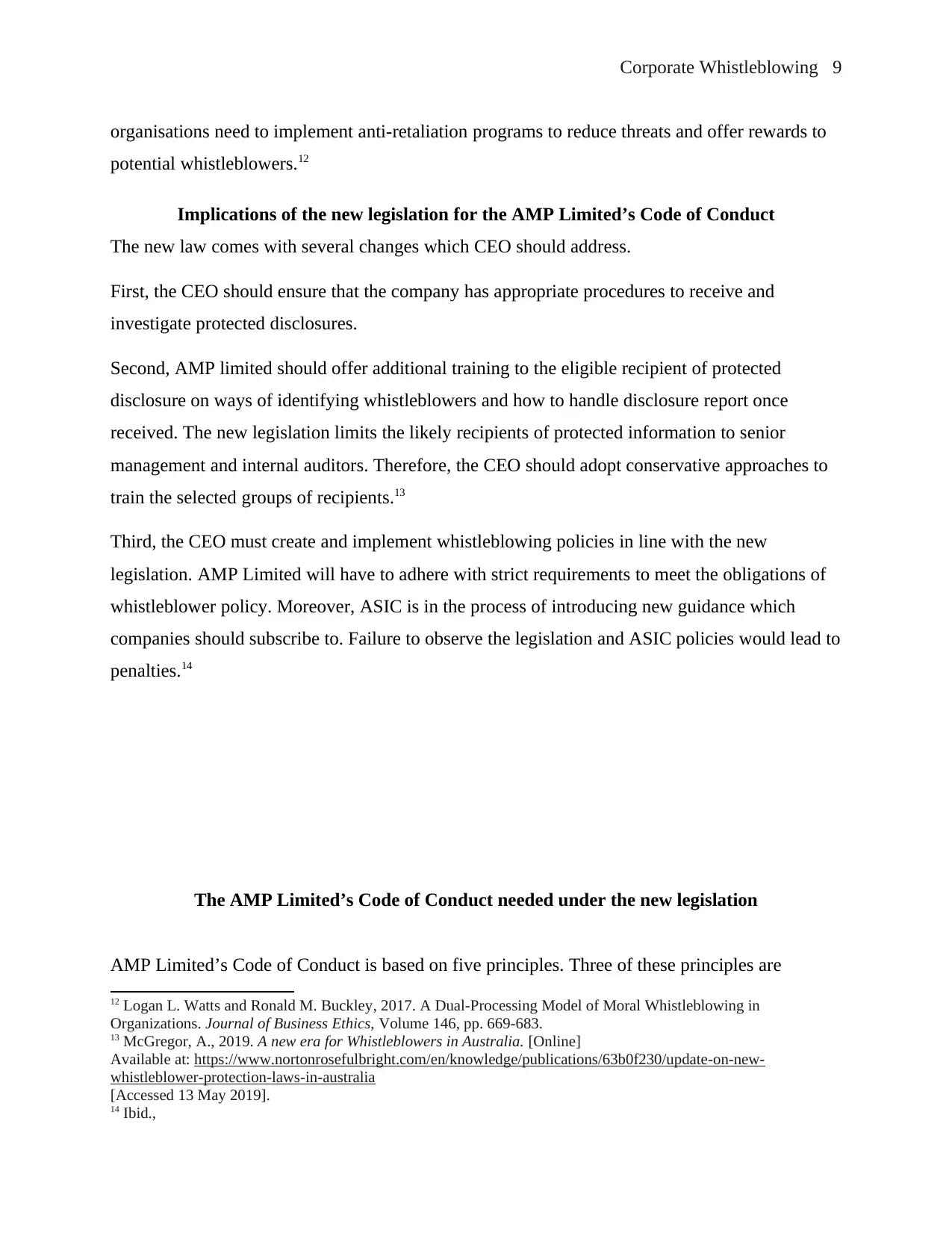
Corporate Whistleblowing 9
organisations need to implement anti-retaliation programs to reduce threats and offer rewards to
potential whistleblowers.12
Implications of the new legislation for the AMP Limited’s Code of Conduct
The new law comes with several changes which CEO should address.
First, the CEO should ensure that the company has appropriate procedures to receive and
investigate protected disclosures.
Second, AMP limited should offer additional training to the eligible recipient of protected
disclosure on ways of identifying whistleblowers and how to handle disclosure report once
received. The new legislation limits the likely recipients of protected information to senior
management and internal auditors. Therefore, the CEO should adopt conservative approaches to
train the selected groups of recipients.13
Third, the CEO must create and implement whistleblowing policies in line with the new
legislation. AMP Limited will have to adhere with strict requirements to meet the obligations of
whistleblower policy. Moreover, ASIC is in the process of introducing new guidance which
companies should subscribe to. Failure to observe the legislation and ASIC policies would lead to
penalties.14
The AMP Limited’s Code of Conduct needed under the new legislation
AMP Limited’s Code of Conduct is based on five principles. Three of these principles are
12 Logan L. Watts and Ronald M. Buckley, 2017. A Dual-Processing Model of Moral Whistleblowing in
Organizations. Journal of Business Ethics, Volume 146, pp. 669-683.
13 McGregor, A., 2019. A new era for Whistleblowers in Australia. [Online]
Available at: https://www.nortonrosefulbright.com/en/knowledge/publications/63b0f230/update-on-new-
whistleblower-protection-laws-in-australia
[Accessed 13 May 2019].
14 Ibid.,
organisations need to implement anti-retaliation programs to reduce threats and offer rewards to
potential whistleblowers.12
Implications of the new legislation for the AMP Limited’s Code of Conduct
The new law comes with several changes which CEO should address.
First, the CEO should ensure that the company has appropriate procedures to receive and
investigate protected disclosures.
Second, AMP limited should offer additional training to the eligible recipient of protected
disclosure on ways of identifying whistleblowers and how to handle disclosure report once
received. The new legislation limits the likely recipients of protected information to senior
management and internal auditors. Therefore, the CEO should adopt conservative approaches to
train the selected groups of recipients.13
Third, the CEO must create and implement whistleblowing policies in line with the new
legislation. AMP Limited will have to adhere with strict requirements to meet the obligations of
whistleblower policy. Moreover, ASIC is in the process of introducing new guidance which
companies should subscribe to. Failure to observe the legislation and ASIC policies would lead to
penalties.14
The AMP Limited’s Code of Conduct needed under the new legislation
AMP Limited’s Code of Conduct is based on five principles. Three of these principles are
12 Logan L. Watts and Ronald M. Buckley, 2017. A Dual-Processing Model of Moral Whistleblowing in
Organizations. Journal of Business Ethics, Volume 146, pp. 669-683.
13 McGregor, A., 2019. A new era for Whistleblowers in Australia. [Online]
Available at: https://www.nortonrosefulbright.com/en/knowledge/publications/63b0f230/update-on-new-
whistleblower-protection-laws-in-australia
[Accessed 13 May 2019].
14 Ibid.,
⊘ This is a preview!⊘
Do you want full access?
Subscribe today to unlock all pages.

Trusted by 1+ million students worldwide

Corporate Whistleblowing 10
deemed relevant to the creation of the whistleblowing policy for the company. First, AMP
Limited requires its employees to observe integrity and honesty and act professionally. The
company describes behaving professionally as being respectfully, somewhat, sincerely, and
truthfully while dealing with stakeholders. Second, the company expects its employees to respect
privacy and confidentiality. AMP strives to maintain the trust other stakeholders have while
sharing their personal information. The company has put in place security standards to maintain
the privacy of information. Moreover, AMP observes confidentiality by ensuring that information
is used for the intended purpose per the law.
Third, AMP promoted the compliance of legal and regulatory procedures as well as internally
established policies and standards. Moreover, the company promises to appropriately and
promptly deal with breaches of both internal and external legal and regulatory standards and
procedures. The whistleblower policy will become part of the company’s internal rules.
Moreover, it is a statutory requirement for the company to have a whistleblower policy in place.
The successful creation and implementation of the policy will depend on the code of conduct
principles mentioned above.
Conclusion
The paper have addressed the concerns raised by the CEO of the AMP Limited about the content
and the implication of the new whistleblower law on the operations of the company. In
responding to the CEO’s concerns, the paper addressed key issues that led to the introduction of
the new whistleblowing legislation in Australia. The new law was introduced to address the
loopholes experienced under the previous legislation.
A comparison of the latest and prior legislation showed that the former is an improved version of
the latter. First, the range of conducts that can be reported and protection offered to the
whistleblowers has been expanded. Second, the previous legislation did not allow anonymous
disclosures while the new legislation accepts anonymous disclosures. Third, it is no longer
mandatory that disclosures must be made in good faith. The new law are better for social welfare
because organizations will have to work in the best interest of society. Social contract encourages
whistleblowing because it would promote the legitimacy of corporations. However, AMP
Limited will incur significant penalties by failing to comply with the requirement of the
legislation. The new legislation requires companies to put in place whistle-blower policies with
deemed relevant to the creation of the whistleblowing policy for the company. First, AMP
Limited requires its employees to observe integrity and honesty and act professionally. The
company describes behaving professionally as being respectfully, somewhat, sincerely, and
truthfully while dealing with stakeholders. Second, the company expects its employees to respect
privacy and confidentiality. AMP strives to maintain the trust other stakeholders have while
sharing their personal information. The company has put in place security standards to maintain
the privacy of information. Moreover, AMP observes confidentiality by ensuring that information
is used for the intended purpose per the law.
Third, AMP promoted the compliance of legal and regulatory procedures as well as internally
established policies and standards. Moreover, the company promises to appropriately and
promptly deal with breaches of both internal and external legal and regulatory standards and
procedures. The whistleblower policy will become part of the company’s internal rules.
Moreover, it is a statutory requirement for the company to have a whistleblower policy in place.
The successful creation and implementation of the policy will depend on the code of conduct
principles mentioned above.
Conclusion
The paper have addressed the concerns raised by the CEO of the AMP Limited about the content
and the implication of the new whistleblower law on the operations of the company. In
responding to the CEO’s concerns, the paper addressed key issues that led to the introduction of
the new whistleblowing legislation in Australia. The new law was introduced to address the
loopholes experienced under the previous legislation.
A comparison of the latest and prior legislation showed that the former is an improved version of
the latter. First, the range of conducts that can be reported and protection offered to the
whistleblowers has been expanded. Second, the previous legislation did not allow anonymous
disclosures while the new legislation accepts anonymous disclosures. Third, it is no longer
mandatory that disclosures must be made in good faith. The new law are better for social welfare
because organizations will have to work in the best interest of society. Social contract encourages
whistleblowing because it would promote the legitimacy of corporations. However, AMP
Limited will incur significant penalties by failing to comply with the requirement of the
legislation. The new legislation requires companies to put in place whistle-blower policies with
Paraphrase This Document
Need a fresh take? Get an instant paraphrase of this document with our AI Paraphraser
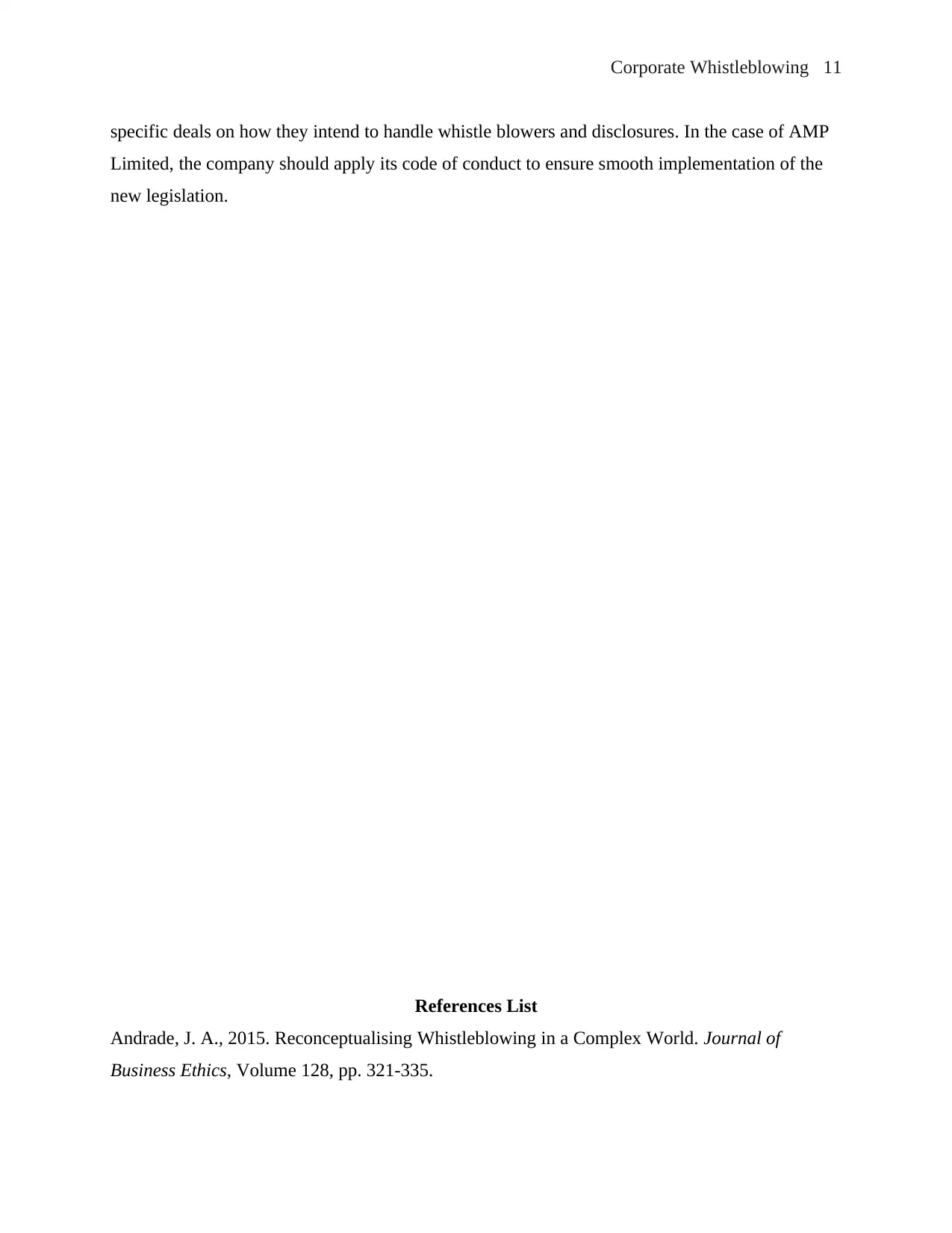
Corporate Whistleblowing 11
specific deals on how they intend to handle whistle blowers and disclosures. In the case of AMP
Limited, the company should apply its code of conduct to ensure smooth implementation of the
new legislation.
References List
Andrade, J. A., 2015. Reconceptualising Whistleblowing in a Complex World. Journal of
Business Ethics, Volume 128, pp. 321-335.
specific deals on how they intend to handle whistle blowers and disclosures. In the case of AMP
Limited, the company should apply its code of conduct to ensure smooth implementation of the
new legislation.
References List
Andrade, J. A., 2015. Reconceptualising Whistleblowing in a Complex World. Journal of
Business Ethics, Volume 128, pp. 321-335.
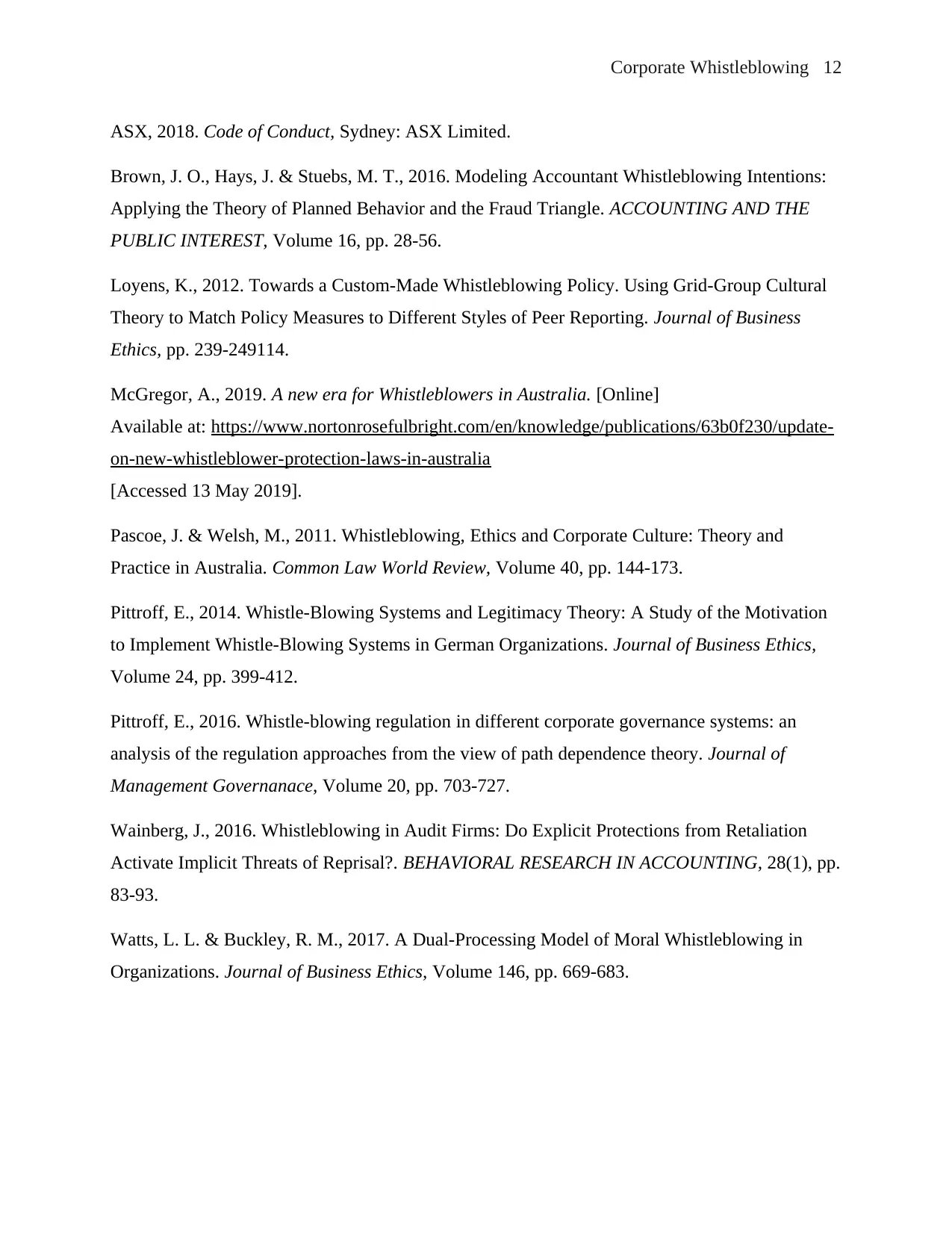
Corporate Whistleblowing 12
ASX, 2018. Code of Conduct, Sydney: ASX Limited.
Brown, J. O., Hays, J. & Stuebs, M. T., 2016. Modeling Accountant Whistleblowing Intentions:
Applying the Theory of Planned Behavior and the Fraud Triangle. ACCOUNTING AND THE
PUBLIC INTEREST, Volume 16, pp. 28-56.
Loyens, K., 2012. Towards a Custom-Made Whistleblowing Policy. Using Grid-Group Cultural
Theory to Match Policy Measures to Different Styles of Peer Reporting. Journal of Business
Ethics, pp. 239-249114.
McGregor, A., 2019. A new era for Whistleblowers in Australia. [Online]
Available at: https://www.nortonrosefulbright.com/en/knowledge/publications/63b0f230/update-
on-new-whistleblower-protection-laws-in-australia
[Accessed 13 May 2019].
Pascoe, J. & Welsh, M., 2011. Whistleblowing, Ethics and Corporate Culture: Theory and
Practice in Australia. Common Law World Review, Volume 40, pp. 144-173.
Pittroff, E., 2014. Whistle-Blowing Systems and Legitimacy Theory: A Study of the Motivation
to Implement Whistle-Blowing Systems in German Organizations. Journal of Business Ethics,
Volume 24, pp. 399-412.
Pittroff, E., 2016. Whistle-blowing regulation in different corporate governance systems: an
analysis of the regulation approaches from the view of path dependence theory. Journal of
Management Governanace, Volume 20, pp. 703-727.
Wainberg, J., 2016. Whistleblowing in Audit Firms: Do Explicit Protections from Retaliation
Activate Implicit Threats of Reprisal?. BEHAVIORAL RESEARCH IN ACCOUNTING, 28(1), pp.
83-93.
Watts, L. L. & Buckley, R. M., 2017. A Dual-Processing Model of Moral Whistleblowing in
Organizations. Journal of Business Ethics, Volume 146, pp. 669-683.
ASX, 2018. Code of Conduct, Sydney: ASX Limited.
Brown, J. O., Hays, J. & Stuebs, M. T., 2016. Modeling Accountant Whistleblowing Intentions:
Applying the Theory of Planned Behavior and the Fraud Triangle. ACCOUNTING AND THE
PUBLIC INTEREST, Volume 16, pp. 28-56.
Loyens, K., 2012. Towards a Custom-Made Whistleblowing Policy. Using Grid-Group Cultural
Theory to Match Policy Measures to Different Styles of Peer Reporting. Journal of Business
Ethics, pp. 239-249114.
McGregor, A., 2019. A new era for Whistleblowers in Australia. [Online]
Available at: https://www.nortonrosefulbright.com/en/knowledge/publications/63b0f230/update-
on-new-whistleblower-protection-laws-in-australia
[Accessed 13 May 2019].
Pascoe, J. & Welsh, M., 2011. Whistleblowing, Ethics and Corporate Culture: Theory and
Practice in Australia. Common Law World Review, Volume 40, pp. 144-173.
Pittroff, E., 2014. Whistle-Blowing Systems and Legitimacy Theory: A Study of the Motivation
to Implement Whistle-Blowing Systems in German Organizations. Journal of Business Ethics,
Volume 24, pp. 399-412.
Pittroff, E., 2016. Whistle-blowing regulation in different corporate governance systems: an
analysis of the regulation approaches from the view of path dependence theory. Journal of
Management Governanace, Volume 20, pp. 703-727.
Wainberg, J., 2016. Whistleblowing in Audit Firms: Do Explicit Protections from Retaliation
Activate Implicit Threats of Reprisal?. BEHAVIORAL RESEARCH IN ACCOUNTING, 28(1), pp.
83-93.
Watts, L. L. & Buckley, R. M., 2017. A Dual-Processing Model of Moral Whistleblowing in
Organizations. Journal of Business Ethics, Volume 146, pp. 669-683.
⊘ This is a preview!⊘
Do you want full access?
Subscribe today to unlock all pages.

Trusted by 1+ million students worldwide
1 out of 12
Related Documents
Your All-in-One AI-Powered Toolkit for Academic Success.
+13062052269
info@desklib.com
Available 24*7 on WhatsApp / Email
![[object Object]](/_next/static/media/star-bottom.7253800d.svg)
Unlock your academic potential
Copyright © 2020–2025 A2Z Services. All Rights Reserved. Developed and managed by ZUCOL.




